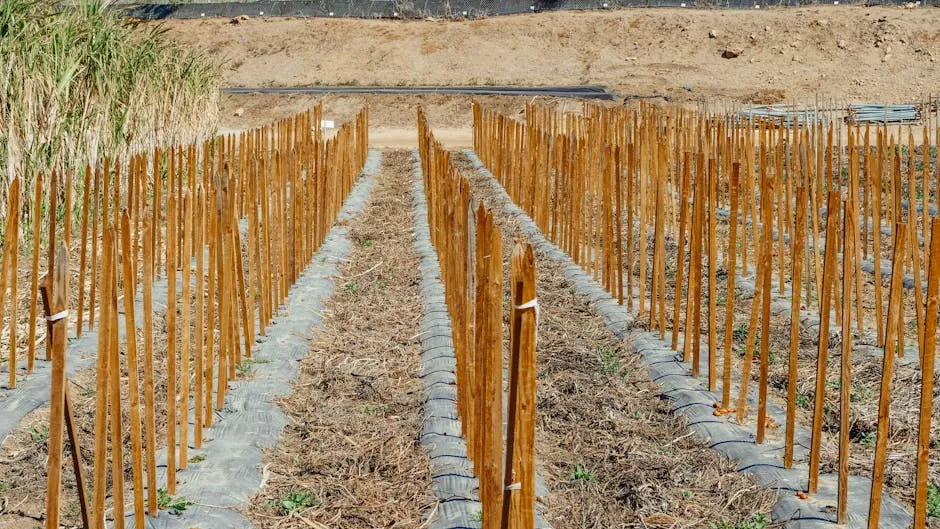Introduction
Survey stakes are vital tools in construction and landscaping. They ensure precise boundary marking and aid in guiding projects. From home gardens to large construction sites, these stakes serve a range of purposes.
Survey stakes are used in various industries, including civil engineering, landscaping, and agriculture. They help define property boundaries and layout plans, making them essential for accuracy. In this guide, we will cover the different types, uses, and key factors to consider when purchasing survey stakes.

Summary and Overview
Survey stakes are markers that guide construction and landscaping activities. They are critical for establishing boundaries and ensuring project accuracy. These stakes come in various materials, including wood, plastic, and metal.
Wooden stakes are often made from durable hardwood, while plastic options provide flexibility and weather resistance. Metal stakes are ideal for heavy-duty projects, offering strength in challenging environments.
Available sizes range from short stakes for small projects to longer ones for extensive layouts. Using high-quality survey stakes enhances project efficiency and accuracy.
If you really want to take your gardening game to the next level, consider investing in Garden Markers. They’ll help you keep track of what’s planted where, so you don’t accidentally uproot your prized tomatoes while searching for that elusive zucchini.

Types of Survey Stakes
Wooden Survey Stakes
Wooden survey stakes are a classic choice for marking boundaries. Typically made from hardwood, these stakes offer strength and durability. Their cost-effectiveness makes them a popular option for both professionals and DIY enthusiasts.
One major advantage of wooden stakes is their ease of use. They can be easily driven into the ground and removed when necessary. This feature is especially beneficial in construction or landscaping projects. Wooden stakes are versatile and can be used for various applications, including site layout and garden planting.
If you’re looking for a reliable tool for driving those stakes in, consider a Survey Stake Mallet. It’s designed for the job and will save you from the embarrassing situation of trying to use a shoe or any other makeshift tool.

Plastic Survey Stakes
Plastic survey stakes are gaining popularity for their lightweight and durable nature. Made from materials like PVC, these stakes are resistant to weather conditions. They won’t warp or break like wood, making them reusable and cost-effective.
Another benefit of plastic stakes is their visibility. They come in bright colors, making them easy to spot on any job site. This feature can reduce accidents and enhance safety during projects.
The flexibility of plastic stakes allows them to bend without breaking, offering a significant advantage in challenging environments. Whether for construction or landscaping, weather-resistant markers are a smart choice. And to keep those stakes in place, you might want to grab a Leveling Tool for perfect alignment.

Metal Survey Stakes
Metal survey stakes are designed for heavy-duty applications. Typically made from aluminum or steel, these stakes are extremely durable. Their robust nature makes them ideal for construction sites and other demanding environments.
One key advantage of metal stakes is their longevity. They can withstand harsh weather and remain visible even in extreme conditions. This visibility is crucial for ensuring safety and accuracy on the job.
Metal stakes are often used in projects requiring precise alignment and durability. They provide reliable markers for boundary definitions in construction and surveying. For those seeking reliable and long-lasting solutions, robust markers made from metal are an excellent investment. And if you’re working outdoors, don’t forget to keep yourself safe with a pair of Safety Goggles!

Uses of Survey Stakes
Construction Applications
Survey stakes are essential for any construction project. They help in layout, grading, and marking boundaries. Imagine starting a building without knowing where the corners are! Construction marking ensures everything is placed correctly from the get-go.
For example, in large projects like highways or commercial buildings, stakes guide where foundations should be laid. They mark elevations for grading, ensuring that surfaces are flat and drainage is optimal. Without grading stakes, you could end up with puddles instead of a smooth surface!
To make sure you’re measuring correctly, a good Measuring Tape is a must-have. It’s the trusty sidekick of every construction worker!

Landscaping and Gardening
In landscaping, survey stakes play a crucial role too. They help in planning planting layouts and garden designs. By using garden stakes, you can easily mark where each plant will go.
These stakes also assist in determining elevations for flower beds or raised gardens. Visualizing your garden with landscaping markers can make planning much easier. It’s like creating a blueprint for your green space!
If you’re serious about gardening, consider investing in a Seed Starting Kit. This handy tool will help you cultivate your green thumb and grow those plants from the very beginning!

Surveying and Boundary Marking
Survey stakes are indispensable for land surveying. They help define property boundaries and establish reference points. This is especially important in legal contexts where property lines are disputed.
Boundary stakes mark where one property ends and another begins. This clarity prevents conflicts between neighbors and ensures compliance with zoning laws. Without proper boundary definition, you could accidentally build on someone else’s land.

Buying Guide for Survey Stakes
Choosing the Right Type
When selecting survey stakes, consider the material. Wooden stakes are affordable and easy to use. However, they may not withstand harsh weather conditions. Plastic stakes are lightweight and durable, making them reusable for multiple projects. Metal stakes offer exceptional strength for heavy-duty tasks but may be more expensive.
Think about your project needs. Will the stakes support heavy materials? Consider the weight capacity of each type. Also, assess the environmental conditions. If you work in wet or humid areas, plastic might be the best choice for long-lasting results. Always weigh the selection criteria carefully to ensure durability and effectiveness.
And while you’re at it, don’t forget about your hands! A reliable pair of Gardening Gloves will keep them safe and clean while you work your magic in the garden.

Size and Length Considerations
Size is crucial in selecting survey stakes. Standard lengths typically range from 3 to 8 feet. For most projects, 4-foot stakes work well. However, longer stakes are beneficial for larger sites or areas with dense vegetation. They provide better visibility and support.
Assess your project specifications. If you’re marking boundaries for a large plot, opt for longer stakes. They help maintain sight lines, making it easier to align structures accurately. Choosing the right stake lengths can significantly impact your project’s success.
Speaking of visibility, you might want to consider Outdoor String Lights for your garden. They add a magical touch and ensure you can see what you’re doing even after the sun sets!

Pricing and Availability
Survey stake prices vary based on material and size. Generally, wooden stakes range from $30 to $60 per bundle of 50. Plastic stakes may cost slightly more due to their durability, typically around $40 to $70 per bundle. Metal stakes can range from $50 to $100 depending on the quality and length.
For bulk purchase options, many suppliers offer discounts. Check local hardware stores or online marketplaces for availability. Websites frequently have bundles at competitive prices, making it easier to stock up for your next project. Make sure to compare costs to get the best deals.
And if you’re planning a picnic after all that hard work, consider a Picnic Blanket to relax on!

Best Practices for Using Survey Stakes
Proper Installation Techniques
Installing survey stakes correctly is crucial for stability. Begin by selecting a firm surface for placement. Use a mallet or hammer to drive the stake into the ground at a straight angle. This method ensures it stands tall and secure.
Avoid common pitfalls, like placing stakes too close together or too shallow. Stakes that are too shallow can easily be knocked over by wind or equipment. Similarly, ensure stakes are not buried in soft soil, as this may lead to instability. Always double-check your placement before moving on to the next one.
For those who want to ensure they’re doing it right, a Heavy-Duty Work Gloves can protect your hands while you’re hammering away!

Maintenance and Care
Caring for your survey stakes prolongs their lifespan, especially wooden options. Regularly inspect wooden stakes for signs of rot or damage. If you notice any, replace them promptly to maintain project integrity.
For storage, keep wooden stakes in a dry place to prevent moisture buildup. Cover them or store them indoors when not in use. Plastic and metal stakes require less maintenance but should still be kept away from extreme temperatures to ensure longevity.
And after all that hard work, don’t forget to hydrate! A Reusable Water Bottle is a great way to stay refreshed while you work.

FAQs
What are survey stakes made of?
Survey stakes are commonly made from wood, plastic, or metal. Each material has unique characteristics suited for different applications.
How do I choose the right survey stake for my project?
Consider the project type, environment, and visibility needs. Wooden stakes are economical, while plastic offers weather resistance. Metal stakes provide strength for heavy-duty tasks.
Can I use survey stakes for gardening?
Absolutely! Survey stakes are great for marking plant locations and guiding garden layouts. They help ensure proper spacing and alignment in landscaping projects.
How long do survey stakes typically last?
The lifespan of survey stakes varies by material. Wooden stakes may last a few months to a few years, while plastic and metal stakes can last much longer, depending on environmental conditions.
Where can I buy survey stakes?
You can find survey stakes at local hardware stores or through online suppliers. Many retailers offer bulk purchasing options, making it easy to stock up for your projects.
Please let us know what you think about our content by leaving a comment down below!
Thank you for reading till here 🙂
For more detailed insights on the importance of survey stakes in various applications, check out our dedicated article.
All images from Pexels




